

Leadership Essay Examples: 400, 500, 600, and 1000 Word Samples
- January 5, 2024
Dr. Marvin L. Smith
Leadership is a vital skill that shapes organizations and societies. Studying leadership through essay examples offers valuable insights into effective leadership strategies and challenges. This article focuses on leadership essay examples ranging from 400 to 1000 words, providing a balanced exploration of leadership concepts.
From ethical decision-making to navigating cultural differences, these examples demonstrate leadership’s multifaceted nature. They provide readers with opportunities to analyze real-world scenarios, understand various leadership styles, and gain inspiration for personal development.
Whether you’re a student, professional, or educator, these 400 to 1000-word leadership essays offer a rich resource for understanding effective leadership. As we explore these examples, we’ll uncover key themes and insights that contribute to our understanding of great leadership, encouraging reflection on personal leadership potential and growth areas.
Table of Contents
What is a leadership essay?
A leadership essay explores the concept of leadership, its aspects, and its importance in various contexts. It demonstrates a student’s understanding of leadership principles and their ability to analyze leadership styles.
These essays may define leadership, discuss theories, analyze famous leaders, or explore personal leadership experiences.
They typically include an introduction with a thesis, body paragraphs developing main ideas, and examples from history, current events, or personal experiences.
Leadership essays require critical thinking and analysis, often asking students to evaluate strategies, compare styles, or argue for effective leadership qualities.
Many encourage personal reflection on leadership potential and experiences. Due to leadership’s interdisciplinary nature, these essays may draw from fields like business, politics, education, and social sciences.
Examples of leadership essay
In this article, we present four leadership essay examples of varying lengths, each focusing on a distinct aspect of leadership.
These examples demonstrate how to effectively structure and develop ideas within different word limits.
Ready to transform your writing experience?
Sign up for Blainy today and start writing your papers with confidence!
The Evolution of Leadership Styles in the Digital Age (400 words leadership essay example)
Introduction:
The digital revolution has fundamentally transformed the landscape of leadership, necessitating a shift in traditional leadership paradigms. As technology reshapes communication, collaboration, and organizational structures, leaders must adapt their styles to effectively guide their teams in this new era.
1. Managing Remote and Distributed Teams:
One significant change is the rise of remote and distributed teams. Leaders now manage employees across different time zones and cultures, often without face-to-face interaction. This shift demands a more trust-based leadership approach, emphasizing clear communication and results-oriented management rather than micromanagement. Successful digital-age leaders foster autonomy while maintaining team cohesion through virtual platforms and collaborative tools.
2. Embracing Adaptability and Innovation:
The rapid pace of technological change has elevated the importance of adaptability in leadership. Today’s leaders must be lifelong learners, continuously updating their skills and knowledge to stay relevant. They need to embrace innovation, encouraging their teams to experiment with new technologies and processes. This adaptive leadership style promotes a culture of agility and resilience, essential for navigating the unpredictable digital landscape.
3. Data-Driven Decision Making:
Data-driven decision-making has become another hallmark of digital-age leadership. With access to vast amounts of information, leaders are expected to leverage analytics to inform their strategies. This approach requires a balance between data interpretation and human insight, combining quantitative analysis with emotional intelligence to make well-rounded decisions.
4. Collaborative and Participative Leadership:
The digital age has democratized information, flattening traditional hierarchies. This shift has given rise to more collaborative and participative leadership styles. Effective leaders now act as facilitators, encouraging knowledge sharing and collective problem-solving. They create platforms for open dialogue and harness the collective intelligence of their teams.
5. Transparency and Authenticity:
Transparency and authenticity have gained newfound importance in the digital era. With information readily accessible and shareable, leaders must maintain consistency between their words and actions. Social media and digital platforms have blurred the lines between professional and personal personas, requiring leaders to cultivate a genuine online presence that aligns with their organizational values.
Conclusion:
The digital age has ushered in a new paradigm of leadership. Successful leaders in this era are those who can navigate the complexities of virtual teams, embrace continuous learning, leverage data effectively, foster collaboration, and maintain authenticity. As technology continues to evolve, so too must leadership styles, adapting to meet the challenges and opportunities of our increasingly digital world.
Emotional Intelligence: The Cornerstone of Effective Leadership (500 words leadership essay example)
In the complex landscape of modern leadership, emotional intelligence (EI) has emerged as a critical factor distinguishing exceptional leaders from their peers. This essay explores how EI forms the cornerstone of effective leadership, enhancing decision-making, team dynamics, and organizational success.
1. Understanding Emotional Intelligence in Leadership:
Emotional intelligence, as defined by psychologist Daniel Goleman, encompasses self-awareness, self-regulation, motivation, empathy, and social skills. In leadership, these components translate into the ability to recognize and manage one’s own emotions while understanding and influencing the emotions of others. Leaders with high EI can navigate complex interpersonal situations, foster positive work environments, and inspire their teams to achieve collective goals.
2. Self-Awareness: The Foundation of Emotional Intelligence:
Self-awareness forms the bedrock of emotional intelligence in leadership. Leaders who possess a deep understanding of their own emotions, strengths, weaknesses, values, and motivations are better equipped to lead authentically. This self-knowledge allows them to recognize how their emotions impact their behavior and decision-making, enabling them to respond more effectively to challenging situations. Self-aware leaders are also more likely to seek feedback and continuously improve their leadership skills.
3. Empathy: Building Stronger Team Relationships:
Empathy, a key component of EI, enables leaders to connect with their team members on a deeper level. By understanding and sharing the feelings of others, emotionally intelligent leaders can create a supportive work environment where employees feel valued and understood. This empathetic approach fosters trust, improves communication, and enhances team cohesion. Leaders who demonstrate empathy are better positioned to motivate their teams, resolve conflicts, and navigate the diverse perspectives within an organization.
4. Emotional Regulation: Maintaining Composure Under Pressure:
The ability to regulate one’s emotions is crucial for effective leadership, particularly in high-stress situations. Leaders with strong emotional regulation can remain calm and composed when facing challenges, making rational decisions rather than reacting impulsively. This composure not only helps in crisis management but also sets a positive example for the team, promoting a culture of resilience and level-headedness.
5. Social Skills: Fostering Collaboration and Influence:
Emotionally intelligent leaders excel in social skills, which are essential for building and maintaining relationships, influencing others, and navigating organizational politics. These skills enable leaders to communicate effectively, resolve conflicts diplomatically, and build networks that support their goals and those of their organization. By leveraging their social skills, leaders can create a collaborative work environment that encourages innovation and drives organizational success.
6. Motivation: Inspiring and Driving Performance:
Leaders with high EI are often intrinsically motivated and can effectively inspire and motivate their teams. They understand what drives their team members and can align individual goals with organizational objectives. This ability to motivate goes beyond simple reward systems, tapping into employees’ intrinsic motivations and creating a sense of purpose and engagement in their work.
Emotional intelligence is not just a desirable trait in leadership; it is a fundamental skill set that underpins effective leadership in today’s complex and dynamic business environment. Leaders who cultivate and leverage their emotional intelligence can create more engaged teams, navigate organizational challenges with greater finesse, and drive sustainable success. As organizations continue to evolve, the importance of emotional intelligence in leadership will only grow, making it an essential area of focus for current and aspiring leaders alike.
Ethical Leadership in Times of Crisis (600 words leadership essay example)
In an era of global uncertainties and rapid changes, ethical leadership has become crucial. This essay explores the significance of ethical leadership during crises, examining how principled decision-making and moral integrity can guide organizations through turbulent times while maintaining trust and respect.
1. The Foundation of Ethical Leadership:
Ethical leadership is rooted in a strong moral compass and a commitment to doing what is right, even when faced with difficult choices. During crises, these foundational principles become even more critical as they provide a stable framework for decision-making amidst chaos and uncertainty.
2. Transparency and Communication:
One hallmark of ethical leadership during crises is transparent communication. Ethical leaders provide clear, honest, and timely information about challenges faced by the organization and steps being taken to address them. This transparency builds trust and credibility, essential elements in maintaining stakeholder support during difficult times.
3. Balancing Stakeholder Interests:
Crises often require leaders to make tough decisions that may impact various stakeholders differently. Ethical leaders strive to balance these competing interests fairly and equitably. They consider the long-term consequences of their actions on employees, customers, shareholders, and the broader community.
4. Empathy and Compassion:
During crises, ethical leaders demonstrate empathy and compassion towards those affected. They understand the human impact of their decisions and take steps to mitigate negative consequences where possible. This might involve implementing support programs for employees, offering flexibility in customer policies, or contributing to community relief efforts.
5. Moral Courage and Difficult Decisions:
Crises often demand difficult decisions that may be unpopular or risky. Ethical leaders must have the moral courage to make these decisions based on principles rather than expediency. This might involve admitting mistakes, taking responsibility for failures, or making choices that prioritize long-term sustainability over short-term profits.
6. Adaptability and Innovation:
While staying true to core ethical principles, leaders must also be adaptable in their approach to crisis management. This might mean reevaluating established practices, embracing technological solutions, or reimagining business models to address new realities. The key is to ensure that these adaptations align with the organization’s ethical framework.
7. Building Resilience:
Ethical leaders focus not just on surviving the immediate crisis but on building organizational resilience for the future. They use the crisis as an opportunity to reinforce ethical values, strengthen corporate culture, and develop more robust systems and processes.
8. Accountability and Learning:
After the immediate crisis has passed, ethical leaders maintain accountability for their actions and decisions. They encourage a culture of learning, conducting thorough post-crisis reviews to understand what worked well and what could be improved. This commitment to accountability and continuous improvement reinforces ethical practices and helps prevent future crises.
Ethical leadership in times of crisis is not just about maintaining moral standards; it’s about leveraging those standards to guide an organization through turbulent times. Leaders who prioritize ethical decision-making, transparency, empathy, and accountability are better equipped to navigate crises while maintaining the trust and respect of their stakeholders. In an increasingly complex and volatile world, such ethical leadership is essential for long-term organizational success and societal well-being. As we face future challenges, the principles of ethical leadership will continue to serve as a beacon, guiding leaders and their organizations through the storms of uncertainty towards a more stable and sustainable future.
Cross-Cultural Leadership: Navigating Global Diversity in the Modern Workplace (1000 words leadership essay example)
In today’s interconnected world, cross-cultural leadership has become an essential skill for managers and executives operating in global environments. This essay explores the challenges and opportunities presented by cultural diversity in the workplace, and how effective leaders can navigate these complexities to foster innovation, collaboration, and organizational success.
Cross-cultural leadership refers to the ability to lead and manage teams composed of individuals from diverse cultural backgrounds. It requires a deep understanding of cultural differences, including values, communication styles, work ethics, and decision-making processes. Effective cross-cultural leaders possess cultural intelligence (CQ), which enables them to adapt their leadership style to different cultural contexts and bridge gaps between diverse team members.
Key Challenges in Cross-Cultural Leadership:
1. Communication Barriers:
One of the primary challenges in cross-cultural leadership is overcoming communication barriers. These can stem from language differences, varying communication styles (direct vs. indirect), and nonverbal cues that may have different meanings across cultures. Misunderstandings can lead to conflicts, reduced productivity, and missed opportunities for collaboration.
2. Diverse Work Ethics and Expectations:
Different cultures often have varying perspectives on work-life balance, time management, and professional conduct. For instance, some cultures prioritize punctuality and strict adherence to schedules, while others may have a more flexible approach to time. These differences can create friction within teams and impact project timelines if not properly addressed.
3. Decision-Making Processes:
Cultural backgrounds significantly influence decision-making styles. Some cultures value consensus and group decision-making, while others prefer hierarchical structures where decisions are made by those in authority. Cross-cultural leaders must navigate these differences to ensure all team members feel valued and included in the decision-making process.
4. Conflict Resolution:
Approaches to conflict resolution can vary greatly across cultures. Some may prefer direct confrontation, while others might seek to avoid conflict altogether. Effective cross-cultural leaders must be adept at recognizing these differences and employing appropriate strategies to resolve conflicts in a culturally sensitive manner.
5. Building Trust:
Trust is a critical component of effective leadership, but the process of building trust can differ significantly across cultures. What may be seen as trustworthy behavior in one culture might be perceived as unreliable or insincere in another. Cross-cultural leaders must be aware of these nuances and adapt their approach to building relationships accordingly.
Strategies for Effective Cross-Cultural Leadership:
1. Develop Cultural Intelligence:
Leaders should actively work on developing their cultural intelligence by learning about different cultures, their values, and norms. This can be achieved through formal training, immersive experiences, and regular interaction with people from diverse backgrounds. High CQ enables leaders to anticipate cultural differences and adapt their leadership style accordingly.
2. Practice Active Listening and Empathy:
Cross-cultural leaders must cultivate strong listening skills and empathy to understand the perspectives of team members from different cultural backgrounds. This involves paying attention to both verbal and non-verbal cues, asking clarifying questions, and showing genuine interest in others’ viewpoints.
3. Promote Inclusive Communication:
Establish clear communication protocols that accommodate different cultural styles. This might include using simple language, providing written summaries of meetings, and encouraging team members to ask questions or seek clarification. Leaders should also be mindful of their own communication style and adapt it to ensure clarity across cultures.
4. Create a Culture of Respect and Inclusion:
Foster an organizational culture that values diversity and promotes inclusion. This involves celebrating cultural differences, providing equal opportunities for all team members, and addressing any instances of discrimination or bias promptly and effectively.
5. Implement Cross-Cultural Training Programs:
Invest in comprehensive cross-cultural training programs for all employees, not just leaders. These programs should cover topics such as cultural awareness, unconscious bias, and effective cross-cultural communication. Regular training helps create a more culturally competent workforce and reduces the likelihood of misunderstandings.
6. Establish Clear Expectations and Guidelines:
Develop and communicate clear expectations regarding work ethics, deadlines, and professional conduct. While allowing for some cultural flexibility, having a set of core organizational values and guidelines helps create a common framework for all team members, regardless of their cultural background.
7. Encourage Knowledge Sharing:
Create opportunities for team members to share their cultural knowledge and experiences. This can be done through informal cultural exchange sessions, diversity celebrations, or mentoring programs. Such initiatives promote mutual understanding and help build stronger relationships across cultural divides.
8. Adapt Leadership Styles:
Effective cross-cultural leaders must be flexible in their leadership approach. This might involve adapting decision-making processes, feedback mechanisms, or motivational strategies to align with the cultural preferences of team members. The ability to switch between different leadership styles as needed is crucial for success in diverse environments.
9. Leverage Diversity for Innovation:
Recognize and harness the power of diversity to drive innovation and creativity. Cross-cultural teams often bring together a wide range of perspectives and problem-solving approaches. Leaders should create an environment where diverse ideas are welcomed and integrated into the organization’s strategies and processes.
10. Continuous Learning and Adaptation:
Cross-cultural leadership is an ongoing learning process. Leaders should remain open to feedback, regularly assess their own biases and assumptions, and be willing to adapt their approaches based on new insights and experiences.
Cross-cultural leadership in the modern workplace presents both challenges and opportunities. By developing cultural intelligence, promoting inclusive practices, and adapting leadership styles, leaders can navigate the complexities of global diversity to create high-performing, innovative teams. As organizations continue to expand globally, the ability to lead across cultures will become increasingly vital for success. Those who master cross-cultural leadership will be well-positioned to thrive in the diverse, interconnected business landscape of the future, fostering environments where all team members can contribute their unique perspectives and talents to achieve common goals.
Leadership essay examples offer valuable insights into effective leadership across various contexts. They highlight key themes such as adaptability, ethical decision-making, cultural intelligence, clear communication, and continuous learning.
These examples demonstrate the complexity of leadership in diverse situations, from crisis management to cross-cultural team dynamics. By studying these essays, aspiring leaders and researchers can gain a deeper understanding of leadership challenges and strategies.
They provide practical insights and theoretical frameworks applicable to real-world scenarios, emphasizing the importance of developing a well-rounded leadership approach.
As leadership continues to evolve in response to global challenges, these examples serve as a foundation for understanding core leadership principles and inspire readers to reflect on and develop their own leadership skills.
Frequently asked questions
What is a leadership short essay.
A leadership short essay is a concise piece of writing, typically 400-1000 words, that explores various aspects of leadership. It may discuss leadership theories, personal experiences, case studies, or specific leadership qualities. These essays aim to convey key leadership concepts, challenges, or strategies in a focused and accessible manner.
What is leadership in 150 words?
Leadership is the ability to inspire, guide, and influence others towards achieving a common goal. It involves setting a clear vision, making strategic decisions, and motivating team members to perform at their best. Effective leaders demonstrate strong communication skills, emotional intelligence, and adaptability. They foster a positive environment, encourage innovation, and build trust within their teams. Leadership also requires ethical decision-making, accountability, and the capacity to navigate challenges. Great leaders empower others, recognize individual strengths, and promote personal growth. They balance assertiveness with empathy, and are willing to learn from both successes and failures. Leadership is not just about holding a position of authority; it’s about creating positive change, driving results, and developing future leaders. Ultimately, leadership is a continuous journey of self-improvement and the ability to bring out the best in others.
What are the qualities of good leadership essay?
When writing a good leadership essay, there are several key qualities to focus on. Here are some essential characteristics to include:
- Clear Thesis Statement : A good leadership essay should have a clear and concise thesis statement that sets the tone for the rest of the essay.
- Strong Argumentation : Effective argumentation is critical in a leadership essay. Use logical reasoning, evidence, and examples to support your claims.
- Use of Examples and Anecdotes : Incorporating real-life examples and anecdotes can help illustrate your points and make your essay more engaging.
- Analysis and Interpretation : Analyze and interpret the leadership concepts, theories, and models you’re discussing, and explain how they apply to real-world situations.
- Evidence-Based Research : Use credible sources to support your arguments, and provide evidence-based research to back up your claims.
- Organization and Structure : A good leadership essay should have a logical structure, with a clear introduction, body, and conclusion.
- Effective Use of Transitions : Use transitional phrases and words to connect your ideas and paragraphs, making your essay flow smoothly.
- Clear and Concise Language : Use clear and concise language, avoiding jargon and technical terms that may confuse your readers.
- Critical Thinking : Demonstrate critical thinking by evaluating different leadership approaches, identifying strengths and weaknesses, and proposing solutions.
- Conclusion and Recommendations : Summarize your main points, reiterate your thesis statement, and provide recommendations for future leadership development.
How do you start a leadership essay?
To start a leadership essay effectively:
- Begin with a hook: Use a relevant quote, anecdote, or thought-provoking question to engage the reader.
- Provide context: Briefly explain the importance of leadership or the specific aspect you’ll be discussing.
- State your thesis: Clearly outline the main argument or focus of your essay.
- Preview main points: Briefly mention the key areas you’ll cover in your essay.
- Consider a personal connection: If appropriate, relate the topic to your own leadership experiences or aspirations.
What is leadership in 10 points?
- Vision: Setting clear, inspiring goals for the future.
- Communication: Effectively conveying ideas and listening to others.
- Integrity: Maintaining ethical standards and trustworthiness.
- Decision-making: Making timely and informed choices.
- Motivation: Inspiring and encouraging team members.
- Adaptability: Flexibly responding to changing situations.
- Empowerment: Delegating tasks and fostering others’ growth.
- Emotional Intelligence: Understanding and managing emotions.
- Problem-solving: Addressing challenges creatively and efficiently.
- Continuous Learning: Embracing personal growth and development.
About the Author:
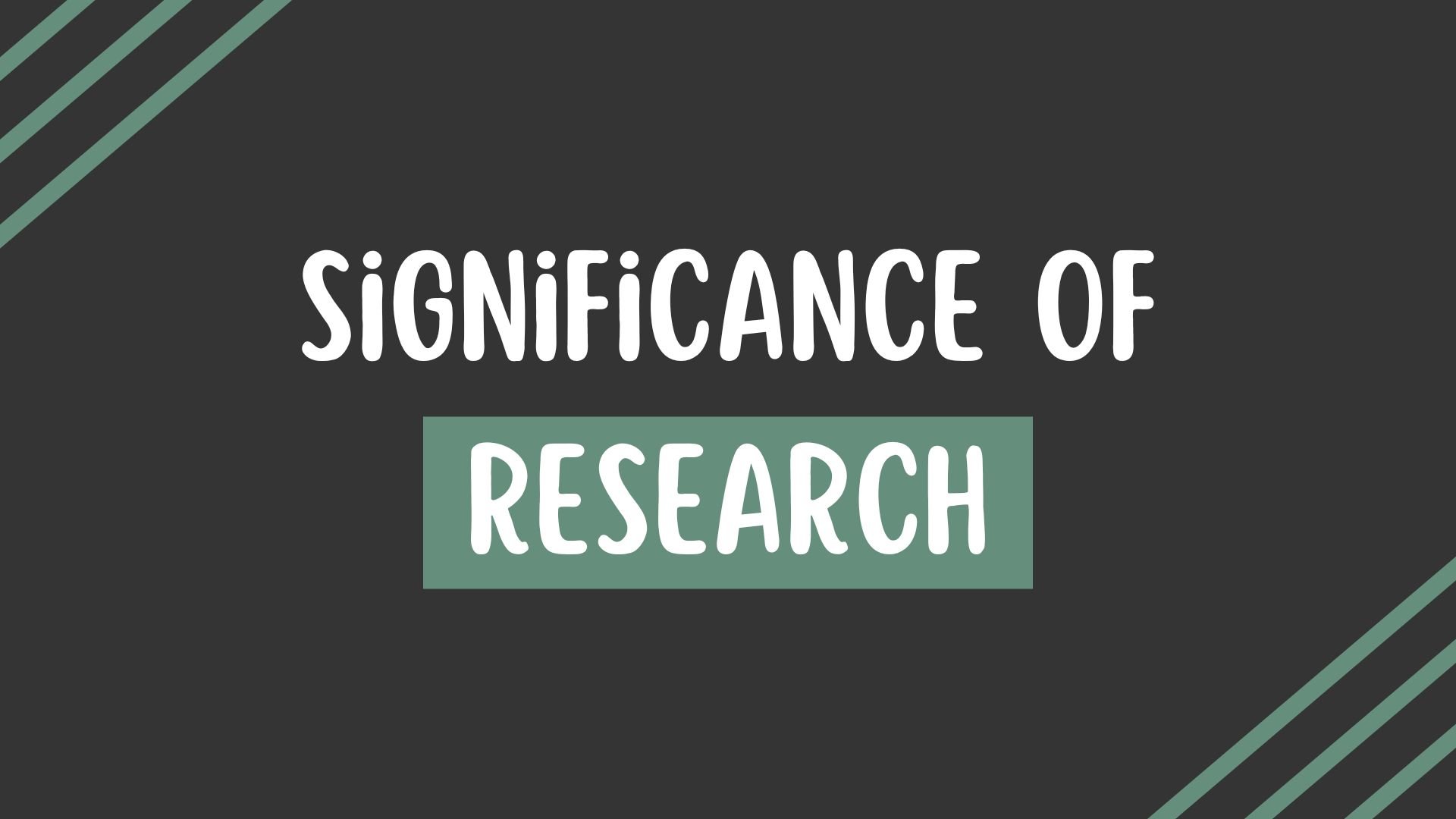
The Significance of Research: Why It Matters
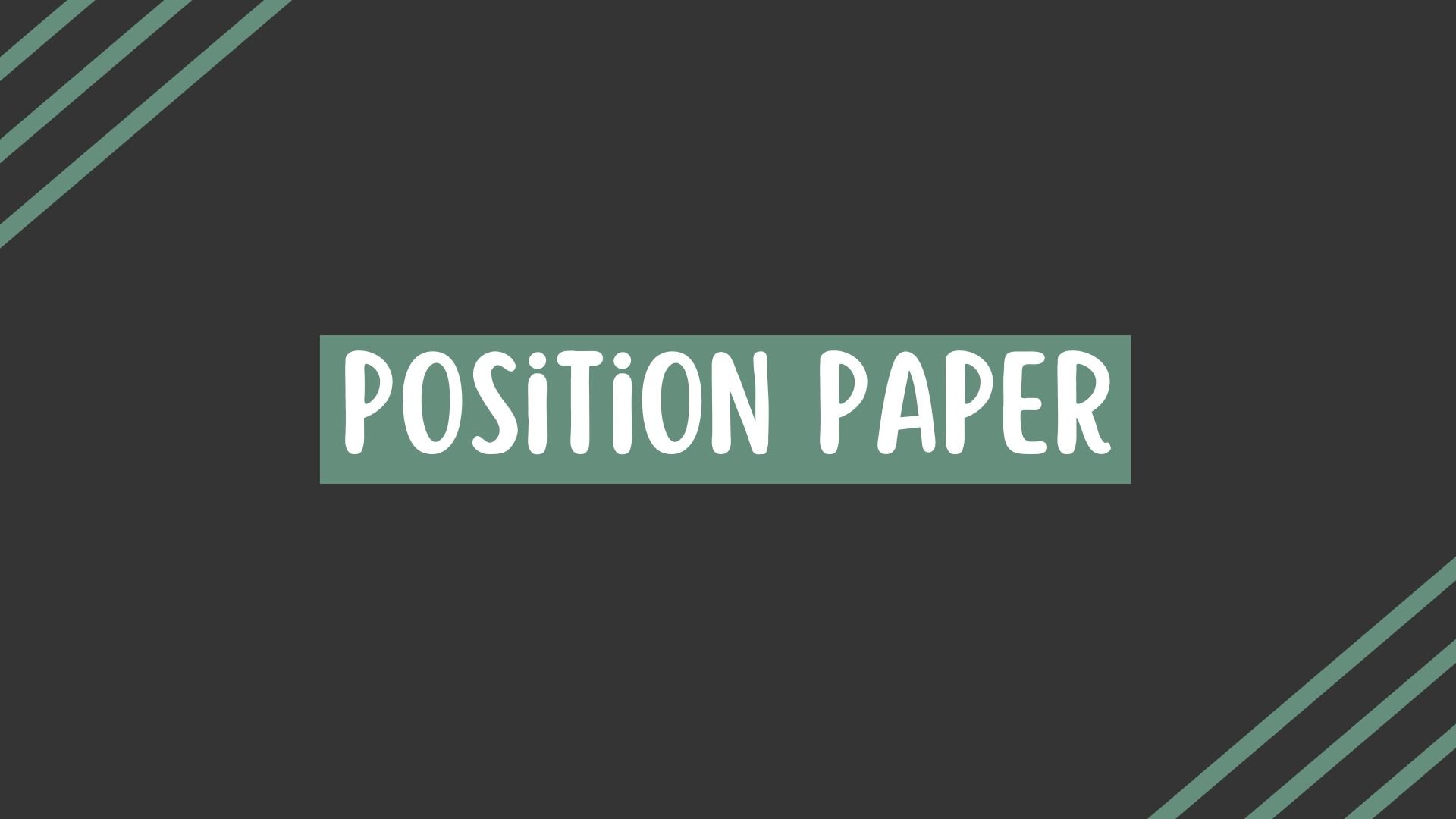

What is a Position Paper? Definition, Purpose & Examples

How to Write a Biographical Essay?
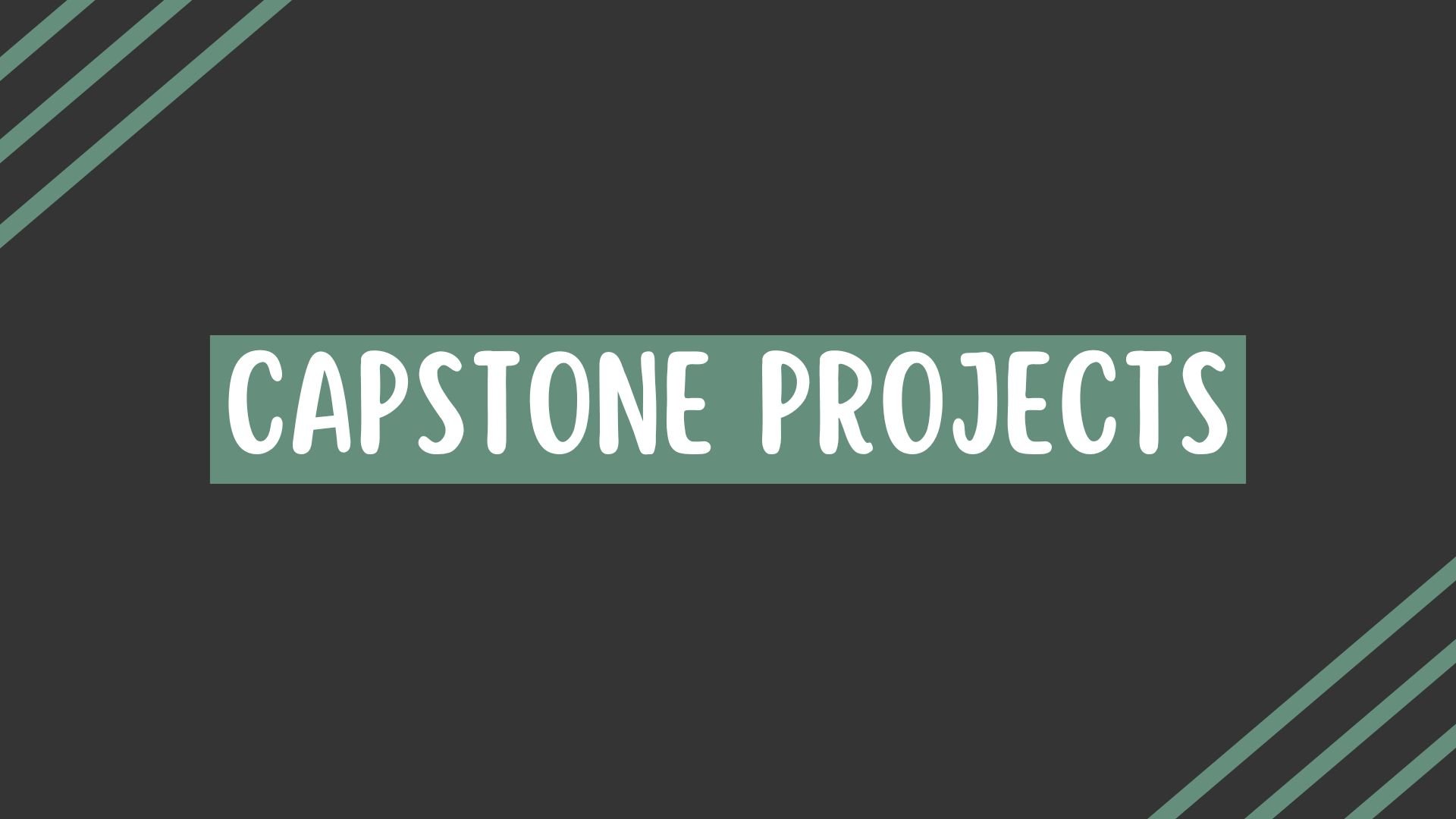
Capstone Projects 101: Definition, Purpose, and More

How to Rephrase a Thesis Statement in 4 Easy Steps
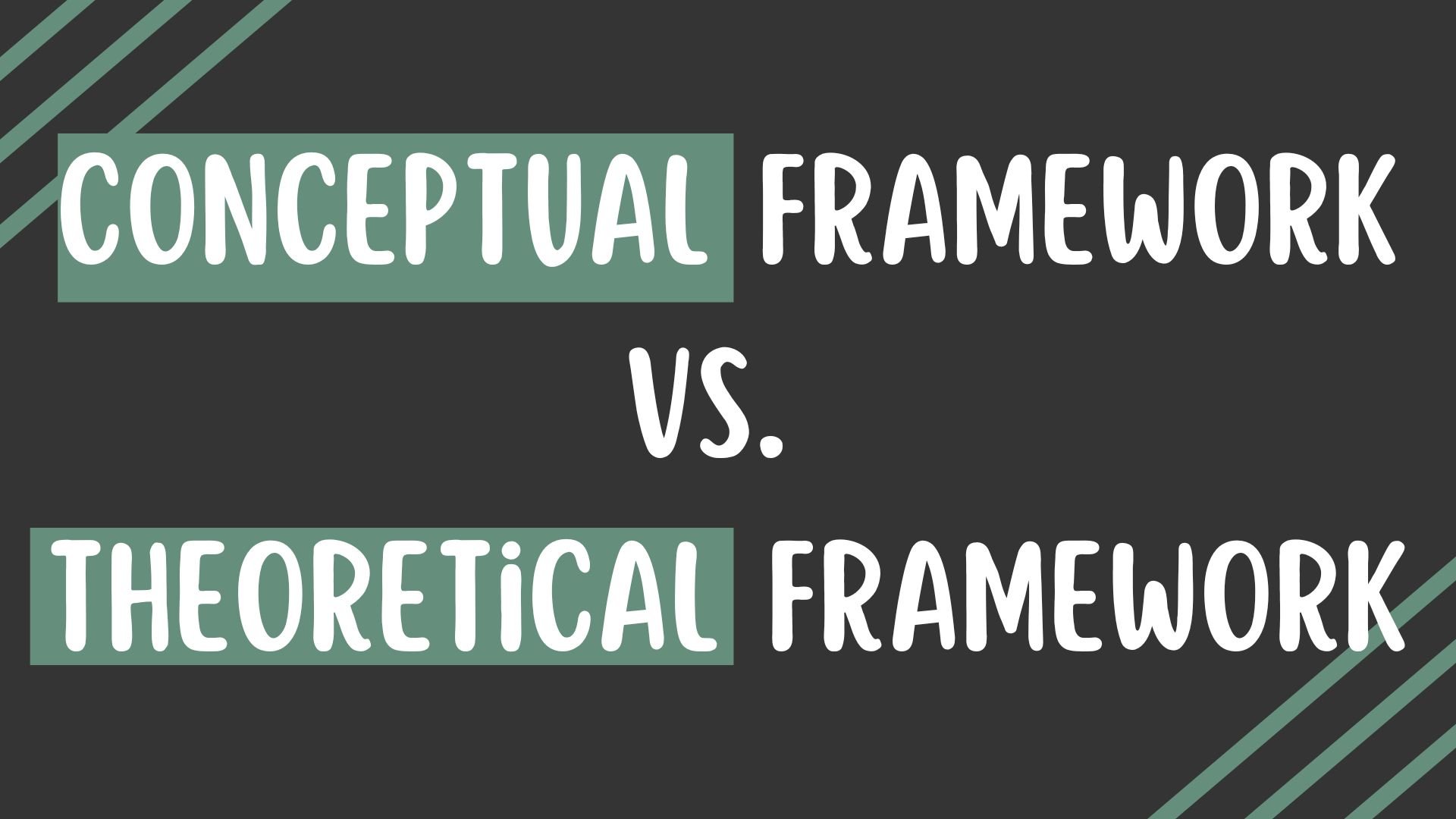
Conceptual Framework vs. Theoretical Framework

Unlock effortless writing excellence with the world's #1 AI-powered essay and research paper writer. Experience instant research paper perfection and elevate your writing to the next level.
Limited time offers 🎁🎉.
Black Friday Sale
Cyber Monday Sale
Discover More
50+ Free AI Tools
Terms & Condition
Privacy Policy
✉ [email protected]
✆ +971 50 760 0820
📍190 Hackett Inlet, Eastern Region, Dubai, UAE.
Copyright © 2024 Blainy
- How to Structure a Leadership Essay (Samples to Consider)
Leadership is a complex concept, but it’s essential for boosting your career. That’s why a leadership essay focuses on applying the theoretical models and concepts of successful management to real-life situations.
If you don’t know where to start writing such a paper, please read on for professional tips!
What Is Leadership Essay?
A leadership essay is a paper that analyzes leadership concepts and their application to real-life situations that may involve everyday business management, crisis situations, and other scenarios.
Every essay on leadership is about defining a concept. Then, it’s either comparing it to similar management tools or proving that it’s useful (or not).
While some students enjoy writing such papers, other learners hate them. The below samples will come in handy, no matter which group is yours.
What Does Leadership Mean to You? (Essay Sample)
It is one of the most popular topics for a leadership essay. If you need to write a paper like that, ask yourself:
- Who is a good leader?
- What style do they use?
- What are the situations when they might switch styles?
You may take a more personal approach to such an essay if your professor allows you to. In the example below, you will see the academic approach to this topic. It analyzes three leadership styles to discover which one corresponds to the meaning of leadership if one thinks of it as guidance and support.
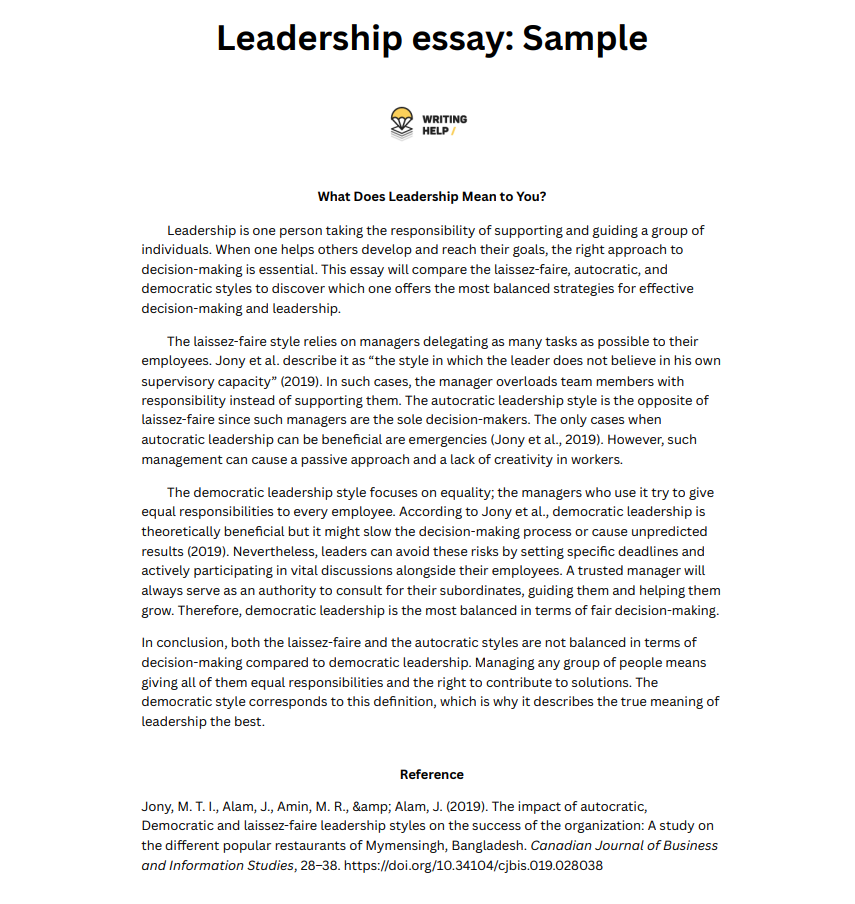
Why I Want to Participate in a Leadership Program (Essay Sample)
It’s another example of a popular topic. Such papers often have a meaning beyond the classroom since they may decide whether you plan to participate in a specific program. It’s critical to make them as effective and compelling as possible.
A personalized approach is the best when it comes to essays like this. In the example below, you will see the paper that relies on individual beliefs and a personal life story to explain why it’s so important for the specific student to participate in the chosen program.
How to Write a Leadership Essay
Like every other essay, this paper has an introduction, several body paragraphs, and a conclusion summarizing your thoughts. (1) The most important part of the introduction is the final sentence, aka a thesis statement. That’s where you state your claim to prove or develop in your leadership essay.
Each body paragraph should correspond to the purpose of your essay. To ensure you don’t stray from the aim you’ve established in the thesis statement, write the topic sentences for all your paragraphs in the outline . In simple words, write the first sentence of every paragraph to define its development in advance and see if you cover everything you need.
And now, to the conclusion:
Its most essential element is thesis restatement or the first sentence of that paragraph. It’s not just paraphrasing your thesis; it’s also considering the new information you’ve discovered while writing the essay.
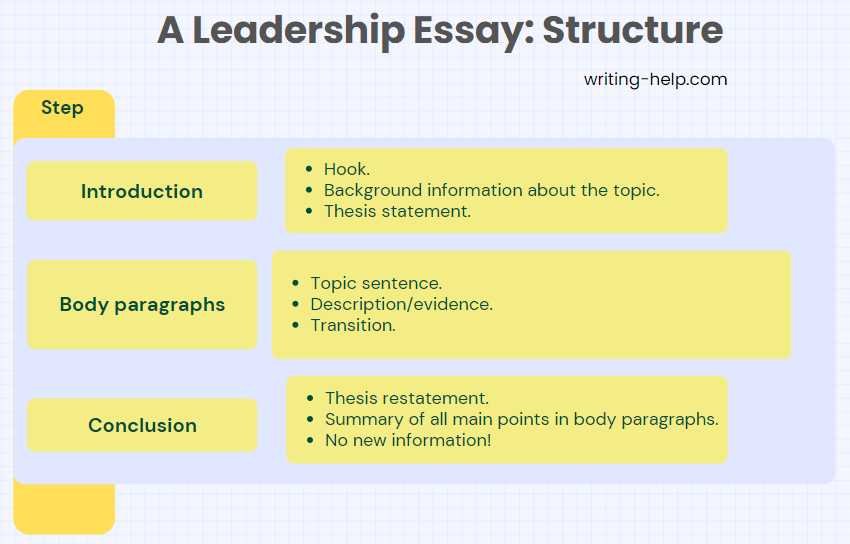
Structure :
- Introduction (End it with a thesis statement.)
- Body paragraphs (Each one starts with a topic sentence.)
- Conclusion (Start it with a thesis restatement.)
Understand the purpose of a leadership essay
When starting to write, think about why you’re creating this paper. Before you sit down and type the words, think about the ideas you want to convey and their meaning in your life:
Can this essay teach you to take responsibility? Or maybe will it help you understand how to be a leader in crisis situations? When you’ve answered the “why” question, begin outlining.
Build a strong thesis
Always start with your thesis statement. It will help incorporate your answer to that notorious “why” question into your essay. Once done, you can plan out the rest of the paper and start working on the body paragraphs as soon as you finish the introduction.
There’s another important tip —don’t rush into writing the conclusion before you finish everything else!
It might seem like a good idea to create a thesis statement and thesis restatement right off the bat. However, you’ll find yourself with more refreshing ideas after completing all the research and thinking necessary for the introduction and each body paragraph.
Decide on a structure; format accordingly
Even if your essay about leadership seems not so formal, and you can use personal pronouns, you still need a clear structure.
The best way to write any academic paper is to keep your introduction and conclusion as short as possible. (But no shorter than three sentences and four lines of text).
Another important tip is to try making all your body paragraphs equal in length. That way, you’ll give the same attention to all the vital points of your essay.
Ready to Write Your Essay on Leadership Now?
Hopefully, this article has helped you understand the most critical elements of a leadership essay.
Remember the structure, grammar, and appropriate academic style to create a top-level paper. Please don’t forget to answer the “why” question and remember why you’re writing. Then you’ll impress everyone with your results!
References:
- https://lsa.umich.edu/onsf/news-events/all-news/directors-blog/writing-leadership-essays.html
- Essay samples
- Essay writing
- Writing tips
Recent Posts
- Writing the “Why Should Abortion Be Made Legal” Essay: Sample and Tips
- 3 Examples of Enduring Issue Essays to Write Yours Like a Pro
- Writing Essay on Friendship: 3 Samples to Get Inspired
- What Is Nursing Essay, and How to Write It Like a Pro

IMAGES
VIDEO